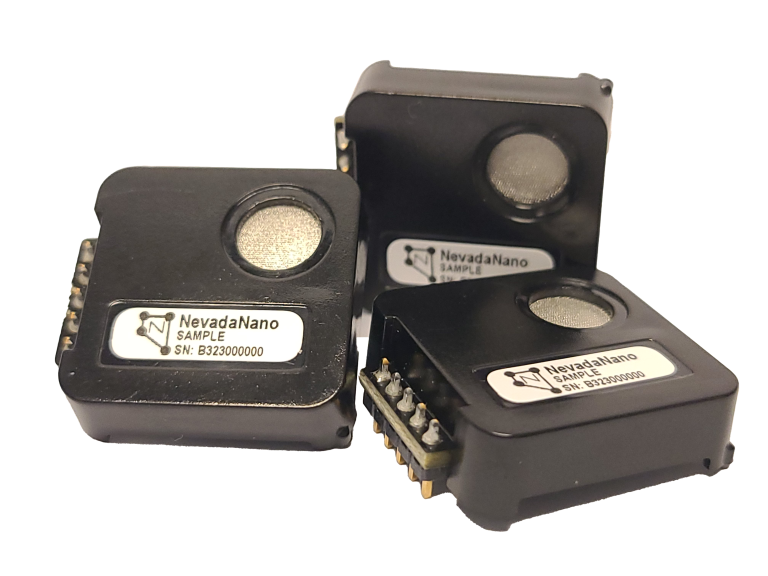MPS™ Refrigerant Gas Sensors
NevadaNano’s Molecular Property Spectrometer™ (MPS™) Refrigerant Gas Sensors provide accurate and reliable detection of refrigerants in existing and emerging applications.
Whether you need to detect mildly flammable low Global Warming Potential (GWP) A2L’s, highly flammable A3’s or even A1 leaks, the MPS™ has best in class performance. With no calibration required for the entire 15+ year lifetime, MPS sensors provide the perfect solution for high customer satisfaction in HVAC-R products.

Safe and Accurate A2L, A3, and A1 Refrigerant Detection
NevadaNano's MPS™ (Molecular Property Spectrometer™) Refrigerant Gas Sensors are engineered to provide precise and dependable detection of mildly flammable (A2L), highly flammable (A3), and non-flammable (A1) refrigerants commonly used in HVAC applications.

Convenient Output Options
These sensors offer versatile output choices, such as a digital bus and configurable analog voltage output, ensuring a seamless and hassle-free integration process with your existing systems, catering to diverse requirements.

Tailored to Your Needs
With a range of sensor variants available for R410A, R404A, (both A1 refrigerants), R32, R454 blends, (both A2L refrigerants), R290 (A3), and more, you can select the sensor that perfectly aligns with your specific HVAC requirements.
Overview of the MPS™ Refrigerant Gas sensor family
For decades, Heating, Ventilation, Air-Conditioning, and Refrigeration (HVAC-R) technology has relied on the use of refrigerant gases to keep indoor air comfortable and food safe. Unfortunately, most of the refrigerants in use today have high Global Warming Potential (GWP), that is, a high potential to contribute to global warming. Since 2000, HVAC manufacturers have used hydrofluorocarbons (HFCs) extensively, however, they have a high GWP, often thousands of times higher than CO2, and contribute significantly to global warming. The Kigali Amendment to the Montreal Protocol, adopted in 2016, aimed to phase down the production and consumption of HFCs to reduce the impact of refrigerants on the climate. This has led to the use of Low GWP refrigerants, many of which are flammable and pose a safety hazard in case of a refrigerant leak. Currently the HVAC-R industry is transitioning from A1 refrigerants to A2L and A3 refrigerants, which are much better for the environment but require sensors to keep people and property safe.
NevadaNano’s family of Molecular Property Spectrometer™ (MPS™) Refrigerant Gas Sensors serves these fast-changing needs of the Heating, Ventilation, Air-Conditioning, and Refrigeration (HVAC-R) industries with precise and dependable detection of non-flammable (A1), mildly flammable (A2L), highly flammable (A3) refrigerants commonly used in HVAC applications.
Currently this sensor family consists of sensors for R410A, R404A, (both A1 refrigerants), R32, R454 blends, (both A2L refrigerants and R290 (A3), but check with NevadaNano for the latest list as we add more refrigerants often.
The MPS™ comes in two form-factors:
S4

Mini

Our HVAC-R sensors employ the smart sensor technology used in our Flammable Gas sensors, ensuring consistent high performance and reliability. Utilizing smart sensor technology, the HVAC-R sensors provide the following features critical to HVAC-R manufacturers and end users:
- 15+ year sensor life provides maintenance free performance for the life of your equipment.
- Factory calibrated with no field calibration needed for the life of the sensor ensures worry free operation.
- Wide Environmental Operating Range ( -40 to 75C, 0 to 100% humidity, and 80 – 120kPa pressure) to ensure reliable operation in tough HVAC-R environments.
- Built-in environmental compensation (T, RH, P) to provide measurement accuracy across the entire environmental range.
- Inherently immune to poisoning to avoid degradation of the sensor and the need for replacement.
- Intrinsically safe: NevadaNano designed all products to meet ATEX Zone 0/1, UKEX Zone 0/1 and IECEx Class 1, Division 1 requirements to ensure safe operation even in the event of a leak.
- Built-In-Self-Test (BIST) within the sensor provides positive assurance that the sensor is operating correctly and within specifications.

The Molecular Property Spectrometer™ (MPS™) Sensor Technology
The heart of our HVAC-R sensors is NevadaNano’s proprietary Molecular Property Spectrometer™ (MPS™). NevadaNano originally developed the MPS for demanding military applications and thirty patented inventions and over one hundred trade secrets power the technology. As a truly smart sensor with Built-In-Self-Test, analog or digital outputs and integrated environmental compensation, these sensors perform dozens of measurements to monitor the environment, verify the gas composition and measure the concentration of gas in the air during each measurement cycle to ensure that the reported concentration is more accurate than any other sensor. In addition, the use of rugged materials and self-cleaning technology ensures that these sensors provide best-in-class performance as the industry’s first sensor not requiring field calibration. Eliminating the requirement for calibration allows customers to use the sensors in demanding, cost sensitive, applications, knowing that expensive calibration or replacement is unnecessary. All of this creates a highly attractive total cost of ownership compared to traditional sensors.
For more information about the MPS™ technology
Third Party Validated Performance
Multiple parties have completed performance testing of NevadaNano’s HVAC-R sensors. This includes extensive testing at NevadaNano, thorough evaluation by our customers and evaluation by the Air-Conditioning, Heating and Refrigeration Technology Institute (AHRTI), a product test lab that serves over 300 HVAC-R manufacturers. NevadaNano’s sensor was the only sensor of eleven sensors evaluated by AHRTI that met all the test criteria required for detecting A2L refrigerant leaks. In all, AHRTI evaluated twenty-eight criteria, evaluating the sensor against the following specs:
- IEC 60335-2-40 (International Electrotechnical Commission).
- UL/CSA 60335-2-40 (Underwriters Lab and Canadian Standards Association).
- ASHRAE 15 (American Society of Heating, Refrigerating and Air-Conditioning Engineers).
- JRA Standard 4068T (Japan Refrigeration and Air Conditioning Industry Association).
MPS™ Refrigerant Gas Sensors Demo Video
Applications and Industries

HVAC-R
- Residential Air Conditioning – all types
- Commercial Air Conditioning
- Industrial Air conditioning
- Data Center cooling
- Server farm cooling
- Hospitals and health care
- Educational Institutions
- Grocery / Food Retail
Heat Pumps and VRF/VRV Air Conditioning
- Commericial and Residential Air Conditioning
- Offices
- Multi Residency Residential Units
- Care Homes
- Public Buildings
- Hotels


Refrigeration / Cold Chain
- Food Production and Processing
- Cold Storage
- Pharmaceutical Units
- Data Centers
- Process Cooling Supermarket Display Cases – Food Retail
- Vending Machines
